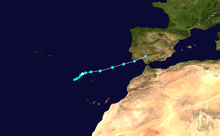I decided to look in more detail into the abundance of tropical activity in Europe. These are conventional tropical cyclones as officially declared by NOAA and do not include Medicanes. A few points to clear up: Hurricane force winds are rare but do occur in the UK. The last time sustained hurricane force winds occurred in the UK was probably 3rd January 2012 in the central belt with winds widely sustained in the low 70s. The 'Michael fish Hurricane' is a more infamous example. However these storms were not hurricanes despite being hurricane strength. A hurricane is a barotropic system, whereas these storms were baroclinic in nature (although often strong baroclinic systems started out life in the tropics as hurricanes). In order to get a true hurricane to hit Europe two criteria would have to be satisfied:
1) Hurricane force winds
2) Storm is barotropic
Satisfying both criteria at the same time is extremely difficult in Europe though I have reason to believe it is actually possible just vanishingly rare (probably a 1 in 1000 year event for the UK). The real issue is getting a tropical cyclone that has already formed to remain tropical long enough to make landfall with the UK. Contrary to popular belief the low sea surface temperatures are not the main issue, but the ultra high wind shear environment that literally rips storms apart. Essentially the problem comes down to the wind shear either being low enough or the storm moving fast enough that the extratropical transition doesn't have time to occur. Both of these two solutions have been attempted.

Above are some schematic tracks with marks depicting the location at which the extratropical transition occurred for storms particularly far north or east. Tropical cyclones originating further south tend to get further north but also decay further west while storms originating further north get much further east. The former category includes very strong cyclones (often storms that obtained major cat3+ status during their lifetime) whilst the later contains much weaker storms (usually TD-C1 strength). In the former case its simply a matter of speed, run as fast as possible so you can die further NE, whilst the later category doesn't need to be strong or fast because the wind shear is marginal rather than devastating.
As you can see from the map storms have nearly made it into Europe with a cluster of dying tropical cyclones just to the south west of the UK and to the west of Spain. Here are a few case Studies.
Hurricane Debbie (1961)
Disputed landfall as a category 1 hurricane in Ireland. However even before the disputed transition the hurricane's cloud field still affected Ireland. Therefore even if it didn't landfall it is the only undisputed case, ever, of a true hurricane affecting the British Isles.

Hurricane Faith (1966)
Underwent extratropical transition as a category 1 hurricane just to the east of the Faero Isles. This is the furthest North a hurricane has ever managed to get before transitioning

Hurricane Vince (2005)
The only undisputed landfall of a tropical cyclone in Europe. Vince briefly made Cat 1 status although it landfilled as a tropical depression in Spain.

Hurricane Chloe (1967)
The closest a barotropic system has ever come to France. Disputed records indicate it may have been within 30 miles of the French coast before the, at that point, tropical storm underwent transition.

Tropical storm Grace (2009)
Probably the closest a barotropic system has ever come to landfalling in great Briton. Its latitude was the same as cornwall when it underwent transition and its remnants (which still had hybrid characteristics) landfilled in wales just a few hours later.

Hurricane Fran (1973)
The category 1 counterpart to Grace. Its transition occurred while it was slightly further south but did so while a catogary 1.

Meeting the first criteria doesn't seem difficult for the UK. Since the UK is further north the systems that come close are more likely to be catogary 1 strength when they transition. For the likes of Spain or France this would be more of an issue with weaker storms having a better chance of staying alive long enough before they transition. Anyway the likes of Faith and Debbie, in particular, prove it is possible for a Storm to hit the UK and SW Scotland is probably the best bet for a category 1 just before transition. It will happen eventually but not necessarily in our lifetimes. Europe is right on the periphery of where a tropical cyclone can survive, and only the most resilient manage to get that far before transitioning.
EDIT: Forgot to mention, if tropical cyclones in unusual places is something that interests you, check out my YouTube video on my top 5 favourite tropical cyclones of all time (some are mentioned above). These are cyclones that ended up in very unusual places!
https://www.youtube.com/watch?v=aZLdB_2Ulzw
Edited by user
12 September 2017 14:15:29
|
Reason: Not specified
Twitter: @QuantumOverlord (general), @MedicaneWatch (medicane/TC stuff)
2023/2024 Snow days (approx 850hpa temp):
29/11 (-6), 30/11 (-6), 02/12 (-5), 03/12 (-5), 04/12 (-3), 16/01 (-3), 18/01 (-8), 08/02 (-5)
Total: 8 days with snow/sleet falling.
2022/2023 Snow days (approx 850hpa temp):
18/12 (-1), 06/03 (-6), 08/03 (-8), 09/03 (-6), 10/03 (-8), 11/03 (-5), 14/03 (-6)
Total: 7 days with snow/sleet falling.
2021/2022 Snow days (approx 850hpa temp):
26/11 (-5), 27/11 (-7), 28/11 (-6), 02/12 (-6), 06/01 (-5), 07/01 (-6), 06/02 (-5), 19/02 (-5), 24/02 (-7), 30/03 (-7), 31/03 (-8), 01/04 (-8)
Total: 12 days with snow/sleet falling.